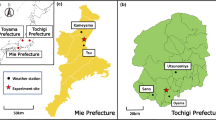Abstract
During long-term monitoring (more than 20 years) of the hydrologic regime at 20 mountainous sites in the Czech Republic (altitude 600–1400 m a.s.l.; vegetation season April-September; mean air temperature 8–10°C; mean total precipitation 400–700 mm; mean duration of sunshine 1100–1300 hours; mean potential transpiration 200–250 mm) it was found that plant temperature does not rise above about 25°C when plants transpire. According to the ecological optimality theory, the phytocenosis that is able to survive unfavourable conditions and produce the biggest amount of phytomass will prevail at sites occurring in long-term stable natural conditions. Simulation of phytomass productivity based on the optimum temperature for plant growth showed that plants with an optimum leaf temperature of about 25°C can survive the unfavourable conditions and produce the largest amount of phytomass at the site studied in the long-term.
Similar content being viewed by others
References
Bodri L. & Čermák V. 1997. Climate changes of the last two millenia inferred from borehole temperatures: results from the Czech Republic — Part II. Global Planet. Change 14: 163–173.
Brdička R. & Dvořák J. 1977. Principles of physical chemistry. Academia, Praha. (In Czech)
Budyko M.I. 1956. The heat balance of the Earth’s surface (translated by N.A. Stepanova 1958). U.S. Dept. of Commerce (Weather Bureau), Washington D.C.
Eagleson P.S. 1978. Climate, soil, and vegetation. 1. Introduction to water-balance dynamics. Water Resour. Res. 14: 705–712.
Grabařová S. & Martinková M. 2000. Changes of Norway spruce (Picea abies/L./ Karst.) growth characteristics under the impact of drought. Ekologia (Bratislava) 19(Suppl. 1): 81–103.
Grabařová S. & Martinková M. 2001. Changes in mineral nutrition of Norway spruce (Picea abies/L./ Karst.) under the impact of drought. Ekologia (Bratislava) 20(Suppl. 1): 46–60.
Grabařová S. & Martinková M. 2002. Climatic risk factors for spruce (Picea abies/L./ Karst.) stands in lower altitudinal vegetation zones. Ekologia (Bratislava) 21(Suppl. 1): 136–151.
Grace J. 1988. Temperature as a determinant of plant productivity, pp. 91–104. In: Long S.P. & Woodward F.I. (eds), Plants and Temperature. Symposia of the Society for Experimental Biology, No. 42. University of Cambridge
Kerkhoff A.J., Martens S.N. & Milne B.T. 2004. An ecological evaluation of Eagleson’s optimality hypotheses. Funct. Ecol. 18: 404–413.
Kleidon A. 2006. Quantifying the biologically possible range of steady-state soil and surface climates with climate model simulations. Biologia 61(Suppl. 19): S234–S239.
Körner Ch. 2003. Functional Plant Ecology of High Mountain Ecosystems. Springer, Heidelberg.
Körner Ch. & Larcher W. 1988. Plant life in cold climates, pp. 25–57. In: Long S.P. & Woodward F.I. (eds), Plants and Temperature. Symposia of the Society for Experimental Biology, No. 42. University of Cambridge.
Larcher W. 2003. Physiological Plant Ecology (Ecophysiology and Stress Physiology of Functional Groups). 4th ed. Springer-Verlag, Berlin, Heidelberg, New York.
Novák V. & Havrila J. 2006. Method to estimating the critical soil water content of limited availability for plants. Biologia 61(Suppl. 19): S289–S293.
Pražák J., Šír M. & Tesař M. 1994. Estimation of plant transpiration from meteorological data under conditions of sufficient soil moisture. J. Hydrol. 162: 409–427.
Schulze E.D., Beck E. & Müller-Hohenstein K. 2005. Plant Ecology. Springer-Verlag, Berlin, Heidelberg, New York.
Spiecker H. 1995. Growth dynamics in a changing environment — long-term observations. Plant Soil 168–169: 555–561.
Střelcová K, Mind’áš J. & Škvarenina J. 2006. Influence of tree transpiration on mass water balance of mixed mountain forests of the West Carpathians. Biologia 61(Suppl. 19): S305–S310.
Tesař M. & Šir M. 1998. Influence of land use on the water regime of soil in the headwater regions, Czech Republic, pp. 357–363. In: Haigh M.J., Křeček J., Rajwar G.S. & Kilmartin M.P. (eds), Proc. 4th Int. Conf. Headwater Control „HEADWATER 98“, Merano, Italy. Balkema, Rotterdam, Brookfield.
Tesař M., Šír M., Syrovátka O., Pražák J., Lichner Ľ. & Kubik F. 2001. Soil water regime in headwater regions — observation, assessment and modelling. J. Hydrol. Hydromech. 49: 355–375.
Vogel T., Huang K., Zhang R. & van Genuchten M.Th. 1996. The HYDRUS code for simulating One-Dimensional Water Flow, Solute Transport, and Heat Movement in Variably-Saturated Media, Version 5.0. Research Report No. 140, U.S. Salinity Lab., ARS, USDA, Riverside, CA.
WRB 1994. World Reference Base for Soil Resources. Wageningen/Rome.
Author information
Authors and Affiliations
Corresponding author
Rights and permissions
About this article
Cite this article
Šír, M., Lichner, Ľ., Tesař, M. et al. Simulation of phytomass productivity based on the optimum temperature for plant growth in a cold climate. Biologia 64, 615–619 (2009). https://doi.org/10.2478/s11756-009-0109-4
Received:
Accepted:
Published:
Issue Date:
DOI: https://doi.org/10.2478/s11756-009-0109-4




